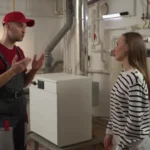Maintaining a comfortable and consistent temperature in your home requires a furnace that operates efficiently. One common issue that can compromise performance is short-cycling, where a furnace frequently turns on and off without completing a full heating cycle. Short-cycling not only increases energy consumption but can also accelerate wear and tear on furnace components, potentially leading to costly repairs. We will explore practical furnace repair and maintenance strategies that help prevent short cycling, ensuring your heating system runs smoothly, uses energy efficiently, and keeps your living space warm throughout the colder months. Taking proactive steps now can save money and reduce frustration in the future.
Discover insights related to this topic—click to read more!
Furnace Repair Tips to Avoid Short-Cycling
Check and Replace Air Filters Regularly
A clogged or dirty air filter is one of the leading causes of short-cycling. When airflow is restricted, the furnace struggles to circulate air properly, causing it to overheat and shut down prematurely. Replacing or cleaning filters every 1–3 months, depending on usage and filter type, ensures smooth airflow and reduces strain on the furnace. Consistently clean filters not only prevent short-cycling but also improve indoor air quality by trapping dust, pollen, and other particles, promoting healthier breathing environments. Additionally, proper airflow helps the furnace maintain consistent temperatures, thereby reducing energy waste and extending the system’s lifespan. Regular filter checks are a simple but highly effective preventive measure.
Inspect the Thermostat Settings
Incorrect thermostat settings or a malfunctioning thermostat can trigger frequent on-and-off cycles. Ensure the thermostat is properly calibrated and positioned away from direct sunlight, drafts, or heat sources that may cause false readings. Upgrading to a programmable or smart thermostat through Southland Heating & Air Conditioning enables more precise temperature control and optimized heating schedules, thereby reducing the likelihood of short cycling. Periodically checking the thermostat for battery life and responsiveness is essential. Small adjustments, such as setting temperature changes gradually instead of drastic shifts, can reduce unnecessary cycling, ensuring the furnace runs efficiently and maintains a stable indoor environment.
Examine the Furnace Size and Capacity
A furnace that is either too large or too small for your home can lead to short cycling. Oversized furnaces heat spaces too quickly, shutting off before completing a full cycle, while undersized furnaces work excessively, struggling to maintain the desired temperature. Consulting a heating professional to evaluate your home’s square footage, insulation, and airflow can determine whether your furnace capacity matches your needs. Proper sizing ensures longer, more efficient cycles, reduces energy waste, and prevents stress on furnace components. Even if the system is relatively new, mismatched capacity can be a root cause of short-cycling and should be addressed promptly.
Maintain Clean and Clear Vents and Ducts
Obstructions in vents or ducts, such as dust buildup, debris, or closed registers, restrict airflow, forcing the furnace to cycle frequently. Conducting a visual inspection of all vents, removing any blockages, and keeping registers open allows air to move freely. Periodic professional duct cleaning may also improve airflow and prevent hidden obstructions that contribute to short-cycling. Properly sealed and insulated ducts reduce heat loss, enhance efficiency, and ensure the furnace doesn’t overwork to achieve desired temperatures. Homeowners should make duct maintenance part of their regular heating system care routine to avoid recurrent short-cycling issues.
Schedule Routine Furnace Maintenance
Regular professional maintenance is crucial for identifying and addressing potential problems before they lead to short-cycling. A technician can inspect heat exchangers, burners, blower motors, and safety controls to ensure the system operates safely and efficiently. Maintenance visits typically include lubrication of moving parts, tightening electrical connections, and testing system performance under load. Scheduling these inspections annually, ideally before the heating season, minimizes unexpected breakdowns and ensures the furnace cycles appropriately. Proactive maintenance supports energy efficiency, enhances comfort, and prolongs the furnace’s overall service life, reducing the likelihood of expensive repairs caused by neglect.
Monitor and Adjust Humidity Levels
Excess humidity in the home can affect furnace operation and contribute to short-cycling. High moisture levels make the air feel warmer than it actually is, causing the thermostat to trigger the furnace to cycle more frequently. Using a dehumidifier or ensuring proper ventilation can balance indoor humidity and reduce unnecessary heating cycles. Maintaining optimal humidity also improves indoor air comfort and protects furniture, flooring, and other household materials from moisture-related damage. Consistent attention to both temperature and humidity creates a more stable indoor environment, allowing the furnace to operate efficiently and avoid frequent shutdowns.
Address Overheating and Safety Switches
Furnace short-cycling is sometimes triggered by overheating, often caused by a blocked flue, failing blower motor, or malfunctioning limit switch. Overheating activates safety mechanisms that shut the furnace down to prevent damage or fire hazards. Inspecting and maintaining these components ensures they function correctly and reduces unnecessary interruptions. If repeated shutdowns occur, a professional evaluation is recommended to replace faulty switches or motors, restoring proper operation. Understanding the relationship between furnace safety features and short-cycling empowers homeowners to identify potential issues early, preventing further complications and promoting safe, reliable heating throughout the season.
Keep Surrounding Areas Clear
Obstructions around the furnace, such as stored items, dust accumulation, or pet hair, can impede airflow and increase the risk of short cycling. Maintaining a clean area around the furnace ensures adequate ventilation, reduces the risk of overheating, and enables the system to function efficiently. Regular cleaning and careful organization of the surrounding area contribute to the overall longevity and performance of the furnace. Ensuring the furnace area is free from clutter is a simple step that supports proper cycling and reduces energy waste.
Preventing furnace short-cycling is essential for maintaining energy efficiency, consistent heating, and prolonging the life of your system. By keeping air filters clean, checking thermostat settings, ensuring proper furnace sizing, maintaining ducts, scheduling regular maintenance, managing humidity levels, addressing overheating issues, and keeping the surrounding area clear, homeowners can reduce the frequency of short-cycling and enjoy reliable, comfortable heating. Taking these proactive steps minimizes energy costs, prevents undue stress on furnace components, and ensures your home remains warm and comfortable throughout the season. Consistent care and attention today lead to smoother and more efficient operations tomorrow.
Check out this featured post that’s trending among readers.






